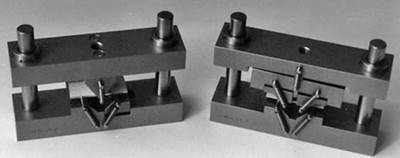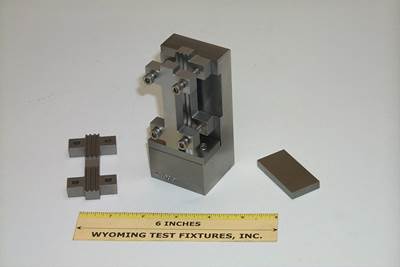Design and Testing
Equibiaxial flexural strength testing of fiber-reinforced ceramics
In my last column, I discussed uniaxial flexural strength testing of fiber-reinforced ceramics, that is, simple three- or four-point bending of a strip of material of rectangular cross section (see "Learn More," at left). As was noted, the strength of this test specimen is sensitive to machining defects at its edges. Also, in many applications of fiber-reinforced ceramics (and unreinforced ceramics), the stress state is not uniaxial, but rather biaxial.
Read MoreFlexural testing of fiber-reinforced ceramics
Because of their brittle nature, ceramics, fiber-reinforced or unreinforced, are difficult to test in pure tension, compression and shear, primarily due to difficulties in gripping and uniformly loading the brittle specimen.
Read MoreTesting Tech: Test fixture and testing machine adapters
In preparation for testing, typically the upper portion of the test fixture is connected to a load cell in the crosshead of the testing machine, and the lower portion of the fixture is connected to the base of the machine.
Read MoreTesting Tech: Multiple-fastener, single-shear laminate bearing strength testing
Dr. Don Adams (Wyoming Test Fixtures Inc., Salt Lake City, Utah) follows up his HPC January 2008 discussion of double-shear testing of a single fastener while advice about testing multiple fasteners under single-shear loading conditions.
Read MoreSingle-fastener, double-shear laminate bearing strength by tensile testing
Dr. Don Adams (Wyoming Test Fixtures Inc., Salt Lake City, Utah) discusses a laminate bearing strength test using double-shear loading of a single fastener.
Read MoreCompression after impact testing
During the late 1960s and most of the 1970s, the composites industry was absorbing the impact of what was then the recent introduction of carbon fiber. The resulting composites exhibited both high strength-to-weight and high stiffness-to-weight ratios. And while it was known that composites reinforced with this new
Read MoreThe modified D695 compression test method
Dr. Don Adams discusses the evolution of the ASTM D 695 compression test method, the predecessor of the D 6641 method now in wide use.
Read MoreComposites test method globalization and harmonization
In my previous column, I discussed the need for standardization of test methods and the progress that has been made in recent years (see “Related Content,” at left). However, we know from that column, and many preceding it, that when we attempt to determine material properties, there is often more than one
Read MoreWhy standardize composites test protocols?
Every column I write for HPC eventually refers to “standard” test methods. But why are standards written? What groups promote these standards, and who actually writes them? Most importantly, why do the rest of us need to follow their standards, and what if we don’t? To answer the first question, we must step back into
Read MoreTesting Tech: Adhesion testing of sandwich panels
In my three preceding columns, I discussed the testing of sandwich panels as unit structures. This included flexural and shear testing of beams and panels. However, such tests — and hardware components that are designed accordingly — will not produce the desired results unless the adhesives that hold these panels
Read More


















